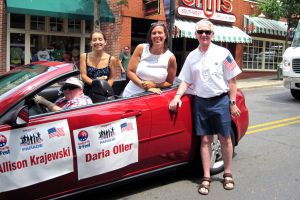
It was right after noon on Good Friday, April 13, 2012, in University Park, PA. Daria Oller, DPT, ATC, PT, CSCS, a PhD Candidate in Kinesiology - Athletic Training and Sports Medicine at Penn State, and Alison Krajewski, MS, ATC, Athletic Training Instructor, were in their academic offices when a squash instructor came running, asking for help. Someone had collapsed on the nearby squash courts. The instructor had already called 9-1-1, but he knew the athletic trainers could help.
Oller rushed to the victim’s side and Krajewski followed with a breathing mask. The 72-year-old man had been down for about five minutes. There was no normal breathing, no pulse, and his skin was “a deep shade of purple.”
“We really did not expect a good outcome,” said Oller. “He was completely unresponsive, although there was some agonal breathing. We thought that, at best, he might survive, but with severe neurological deficit.”
“We thought he was gone,” said Krajewski.
Just the same, Oller gave two breaths and started compressions. “Although I was certified in CPR since middle school, this was the first time I gave CPR to a real person. I have to say that it really helped to have been trained on manikins that light up when you push down hard enough. For some reason, that image kept coming to mind and helped me focus on pushing hard.”
Within minutes, two AEDs arrived at the victim’s side, one retrieved from the facility, the other carried by campus police. Officer Mike Baker took over compressions, Oller switched to breathing, and Officer Randy Hoffman placed the AED electrode pads on the patient’s chest and shocked him four times. Dave King, EMT-P, and the EMS crew administered advanced life support and transported the patient to the local hospital. He was quickly transferred by a Geisinger LifeFlight helicopter to Geisinger Medical Center in Danville, where he was treated with mild therapeutic hypothermia to preserve brain function. He later received a pacemaker/ implantable cardioverter defibrillator (ICD).
The rescuers would soon learn that the victim was Ronald P. Danner, PhD, Emeritus Professor of Chemical Engineering, a faculty member at Penn State for 45 years. Dr. Danner has no recollection of the time surrounding the event—a common experience among SCA survivors.
“Everything I tell you, of course, is second hand information,” said Danner in an interview with the Sudden Cardiac Arrest Foundation. “I don’t even remember hitting the ground. But I understand that the way things fell in line was incredible. I’m doing great. They saved my life,” he said, referring to Oller, Krajewski, and the entire team.
The cause of the arrest has not been determined, though Danner suffered a myocardial infarction in 1978. Heart attacks are often precursors of sudden cardiac arrest.
Remarkably, even though Danner was “down quite a bit of time before they could get my pulse back,” he feels like his old self, a fact that he attributes in part to mild cooling. “From what I understand, I was cooled for about 30 hours. My doctors say I’ve made a marvelous recovery. I came out of it with complete clarity. I feel perfectly normal.”
Since CPR was administered for at least 25 minutes, though, Danner experienced significant discomfort following the event. “My ribs were cracked, so it took several weeks before I could cough or sneeze without pain. But I’ll take that any day,” he said, “over the alternative.”
Now, though Danner is technically retired, he is back to doing research and will teach a freshman chemical engineering seminar in the fall. “My wife says I should add N.R.R. to my title—“Not Really Retired.” He goes to cardiac rehab three times a week, and hopes to return to playing squash soon. “I’ve always tried to live a healthy lifestyle,” he said.
On July 4th, Penn State conducted its first Parade of Heroes. Danner had nominated Oller and Krajewski for the coveted award and they were among a total of 19 nominees whose heroic actions were celebrated to great fanfare.
But Danner’s heroes remain grounded and humble. “It was a group effort—the staff, the campus police, the EMTs—everyone acted so fast,” said Krajewski.
“For me, it was a learning experience, especially witnessing agonal breathing that occurred even when the patient was intubated, and understanding how much force is needed to pump the heart effectively.” The other thing she learned is that “using the AED is the easy part. A monkey could use one without being trained.”
Oller, too, appreciates the way it all came together. “I’m just so happy that someone knew where we were and knew to come and get us.”
She’s also grateful for her training. She credits her mentor, Ron Courson, ATC, PT, NREMT-I, at the University of Georgia, for preparing her so well for medical emergencies and stressing the importance of reviewing every event to determine areas for improvement. “We’re going back and analyzing everything to see what we can learn from this and how we can do better next time.”
The bottom line: It was a very "good" Friday. Shortly afterwards, Oller and Krajewski each received a dozen roses from Danner, with a simple card that said it all: “Thank you for saving my life.”
-Mary M. Newman, MS
